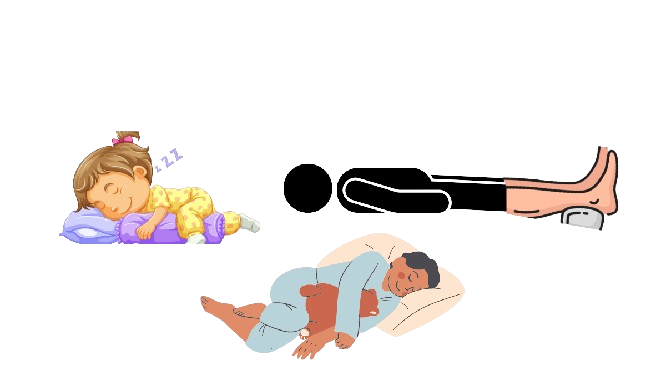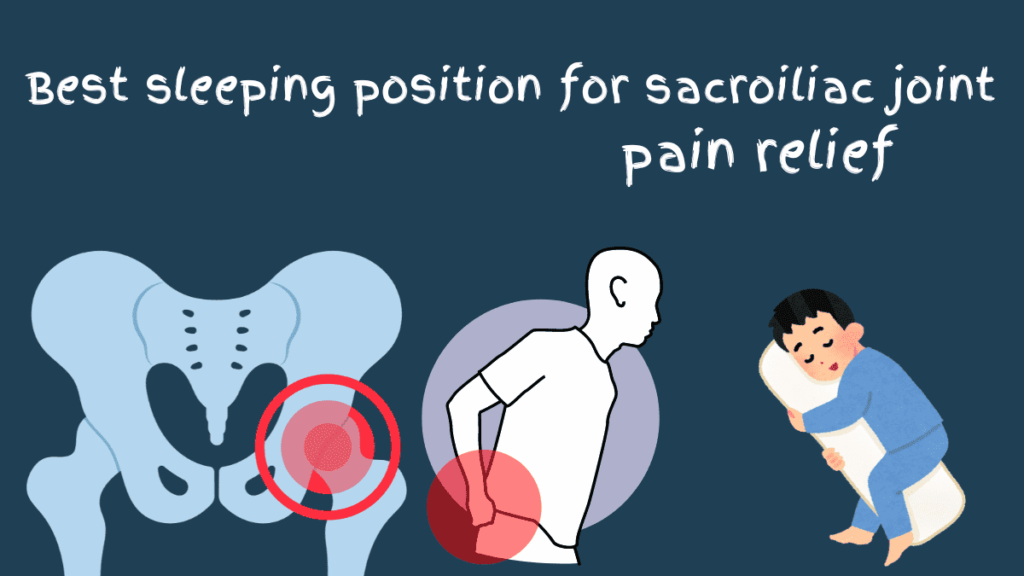Dealing with discomfort during the day is challenging enough,
But when your sacroiliac joint pain disrupts your sleep, it can directly affect your quality of life. The sacroiliac joints, located where the spine meets the pelvis, play a crucial role in transferring weight and force between your upper body and legs.
When these joints become inflamed or injured, the resulting pain can make finding a comfortable sleep position difficult.
Common Causes of Sacroiliac Joint Pain
Sacroiliac joint pain can arise from various factors that affect the stability and function of these crucial joints. The primary causes include:
Joint Dysfunction: When the sacroiliac joints become misaligned or move improperly, it can lead to irritation and inflammation, causing pain.
Degenerative Arthritis: Wear and tear over time can result in osteoarthritis of the sacroiliac joints, causing pain and stiffness.
Pregnancy: Hormonal changes during pregnancy can loosen the ligaments around the sacroiliac joints, leading to instability and pain.
Trauma or Injury: Impact from falls, accidents, or sports injuries can damage the sacroiliac joints or surrounding tissues, triggering pain.
Overuse or Repetitive Motion: Activities that place repetitive stress on the sacroiliac joints, such as running or heavy lifting, can cause inflammation and pain.
The Importance of Proper Sleeping Position
The importance of proper sleeping position cannot be overstated, especially when it comes to managing conditions like SI (sacroiliac) joint pain. The sacroiliac joints connect the sacrum (the triangular bone at the bottom of the spine) to the ilium (the pelvic bone), and they play a crucial role in supporting the weight of the upper body when we stand, walk, or move.
Here’s how sleep position can affect SI joint pain:
Alignment: Sleeping in a position that maintains proper spine and pelvis alignment is essential. Misalignment can put extra stress on the SI joints, exacerbating pain. For instance, sleeping on your stomach can twist the pelvis and strain the SI joints.
Support: Proper lower back and pelvis support can help alleviate SI joint pain. Sleeping on a firm mattress or using pillows strategically placed between the legs or under the pelvis can support and reduce pressure on the SI joints.
Avoiding Overstretching: Some sleep positions, such as sleeping with one leg straight and the other bent (like in a fetal position), can lead to overstretching of the SI joint ligaments. This can cause discomfort and pain, particularly if the ligaments are already inflamed or irritated.
Comfort and Relaxation: Finding a comfortable sleep position is crucial for relaxation and pain management. Experimenting with different positions—such as lying on your back with a pillow under your knees or on your side with a pillow between your legs—can help identify what works best for reducing SI joint pain.
Posture During Sleep: Maintaining good posture even while sleeping can contribute to better SI joint health. This includes keeping the spine in a neutral position and avoiding positions that excessively rotate or twist the pelvis.
Pillow Support: Using pillows strategically can help maintain proper alignment and reduce pressure on the SI joints. For example, placing a pillow under the pelvis or between the knees can help keep the spine and pelvis in alignment, reducing strain on the SI joints.
Regular Movement: While not directly related to sleep position, incorporating regular movement and stretching exercises throughout the day can help improve flexibility and reduce stiffness in the SI joints, which can contribute to better sleep quality and reduced pain at night.
Recommended Sleeping Positions for Relieving Sacroiliac Joint Pain
Side Sleeping with Pillow Between Knees: This position helps maintain proper alignment of the spine and pelvis, reducing strain on the SI joints. Placing a pillow between the knees further supports this alignment and alleviates pressure.
Back Sleeping with Knees Elevated: Sleeping on your back with your knees elevated on pillows or a cushion can also promote proper spinal alignment. This position reduces pressure on the lower back and SI joints, offering relief from discomfort.
Proper Alignment Techniques: Ensuring the spine and pelvis are in neutral alignment during sleep is crucial. Avoiding positions that twist or rotate the pelvis excessively helps prevent strain on the SI joints and minimizes pain.
These recommended sleeping positions not only promote comfort but also support SI joint health by reducing pressure and maintaining alignment.

Sleeping Positions to Avoid
there are certain sleeping positions you should avoid as they can aggravate the discomfort. Here are some positions to steer clear of:
Stomach Sleeping: This position can strain the lower back and pelvis, putting pressure on the sacroiliac joints. It also twists the spine unnaturally.
Twisted or Curled Up: Any position that twists or curls your spine asymmetrically can exacerbate sacroiliac joint pain. This includes fetal positions or any position where one leg is significantly bent and the other straight.
Flat on Back with Legs Straight: This can sometimes lead to hyperextension of the spine, which may aggravate sacroiliac joint pain in some individuals.
FAQ FOR sacroiliac joint
What exercises can help with SI joint pain?
Gentle stretching and strengthening exercises targeting the core, hips, and lower back can help alleviate SI joint pain.
How do I know if my pain is from the sacroiliac joint?
Pain localized on one side of the lower back or buttocks, often worsened by certain movements like bending, twisting, or sitting, may indicate sacroiliac joint dysfunction.
Tell me more about the anatomy of the SI joint.
The sacroiliac joint connects the sacrum (triangular bone at the base of the spine) to the ilium (part of the pelvis), supporting stability and transmitting forces between the spine and lower body during movement.
What is the best sleeping position for sacroiliac joint pain relief?
Side sleeping with a pillow between your knees can help alleviate sacroiliac joint pain.
How does side sleeping with a pillow between the knees help?
This position helps maintain pelvic alignment and reduces strain on the sacroiliac joints.
Should I avoid sleeping on my stomach if I have sacroiliac joint pain?
Yes, stomach sleeping can aggravate sacroiliac joint pain by causing excessive arching of the back.
When to Seek Professional Help
Experiencing sacroiliac joint pain can be distressing, especially when it disrupts your sleep and daily activities. While certain sleeping positions can alleviate discomfort, persistent pain may necessitate professional evaluation. Here are key signs indicating it’s time to seek expert guidance:
Persistent Discomfort: If your sacroiliac joint pain persists despite trying different sleeping positions and home remedies, it’s crucial to consult a healthcare professional. Chronic pain could indicate an underlying issue that requires medical intervention.
Limited Mobility: Difficulty moving or performing everyday tasks due to pain suggests a need for professional assessment. A healthcare provider can conduct tests to identify the exact cause of your discomfort and recommend appropriate treatment.
Radiating Pain: Pain that radiates down your legs or affects other parts of your body may signify nerve involvement or spinal issues. Such symptoms warrant prompt evaluation by a specialist to prevent further complications.
Night Pain: Pain that worsens at night or interferes with sleep patterns should not be ignored. Sleep disturbances can impact overall health and quality of life, underscoring the importance of seeking medical advice.
Consulting a Healthcare Professional for Persistent Pain
When experiencing persistent sacroiliac joint pain, consulting a healthcare professional is crucial for accurate diagnosis and effective treatment·
- Diagnostic Evaluation: A thorough assessment can pinpoint the exact cause of your sacroiliac joint pain, ruling out other potential conditions such as arthritis or sciatica.
- Personalized Treatment Plan: Based on the diagnosis, your healthcare provider can recommend tailored interventions to alleviate pain and improve mobility. This may include physical therapy, medications, or in some cases, injections or surgical options.
- Monitoring and Adjustments: Regular follow-ups allow healthcare professionals to monitor your progress and make necessary adjustments to your treatment plan. This ensures optimal management of sacroiliac joint pain over time.
Conclusion
conclusion, finding the best sleeping position for sacroiliac joint pain relief is an essential aspect of managing discomfort at night· However, persistent pain requires professional evaluation to address underlying issues effectively· By consulting a healthcare provider promptly, you can receive personalized care and support to improve your quality of life·
Summary and Importance of Finding the Right Sleeping Position
Finding the right sleeping position can significantly alleviate sacroiliac joint pain, promoting better sleep and overall comfort· While experimenting with different positions and supportive aids at home can provide relief, persistent or severe pain necessitates seeking professional help· A healthcare professional can diagnose the root cause of your pain and recommend tailored treatments to manage symptoms effectively· Prioritizing proper sleep posture not only enhances physical well-being but also supports long-term joint health and overall quality of life·
